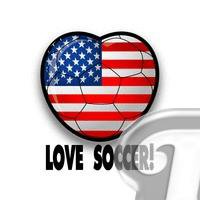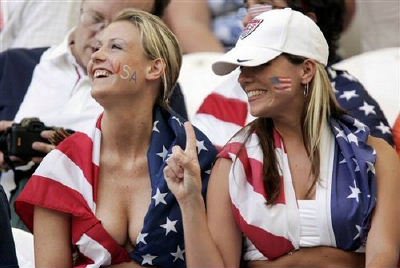An Overview of American Soccer History

The College Era, and Rules Consolidation, 1862-1875
The Working-Class and Immigrant Eras, 1875-1894
The First Dynasties, 1913-1921
The 1960's: The Birth of the American Soccer Renaissance
Outdoor soccer reaches a low: 1985
The Rebirth of Outdoor Soccer, 1988-1994
1994: The World Cup comes to America
From World Cup to Major League Soccer (1995-1996)

The new Golden Era of American Soccer, 1996-2004
1996 was the year of Major league Soccer, which had a very successful first year. Although it was clear soccer had a long way to go, the league drew much better than expected, quality of play was above predictions and fan response was enthusiastic, and financial losses were less than expected. The MLS's financially conservative approach had paid off. The USISL established a Select league of top teams with the intent to petition FIFA for 2nd division status, which was provisionally approved. After the season they changed their approach, and instead merged the select league with the A-League, taking in A-League teams and the league name along with FIFA's recognition. This was also the year for the Olympics, hosted by Atlanta. Although the men didn't do as well as hoped, the women's team won the inaugural Olympic Women's Soccer competition with unprecedented crowds, including 76,000 for the final, demonstrating emphatically that the women's sport was coming of age at the top levels. This success gave the US organizing team (which had won the rights to host the 1999 world cup) leverage to force FIFA to agree to have the event be a full-fledged affair in large stadiums coast to coast, rather than the low-key regional affair preferred by the FIFA old guard. Meanwhile, World Cup '98 qualification was underway, and the US won a spot in November 1977, with a convincing win over Canada. This was the first time since 1989 the US had qualified without help (Mexico had been disqualified for using illegal players). This helped silence the naysayers, as the US would have qualified even if the North American region hadn't received a third allocation.
The following year was mixed for US soccer. The National team gave a very disappointing World Cup performance against very tough competition, but the real reason for the losses was dissension between players and coach Sampson, leading to his resignation and some unhappy players. MLS struggled with falling attendance and flat TV ratings, but the quality of play had improved substantially in each season, and the two new teams, in Chicago and Miami did very well. On the developmental front, the USSF established a new A-League team, US Pro 40, which consisted of the best of the college and ODP recruits, would play together to develop skills and be the cream o the new talent for the MLS and ultimately the National team. This was established in tandem with the new USSF Project 2010, designed to build the National team to the point where they can compete for the World Cup championship. US Pro 40 had a surprisingly good debut year, and even better year in 1999, and was very effective in promoting players to the MLS (All Project 40 players were signed by MLS teams). This ambitious plan, although possibly overoptimistic did indeed provide finally a comprehensive development plan for soccer at multiple levels, and a true blueprint for the development of the National team. Meanwhile, an abortive attempt to launch a women's professional league, the National Soccer Alliance failed, but did provide inspiration, and caused the USISL to seriously consider a plan for eventually turning their elite division into a fully professional league.
The year 1999 had many major success stories, but above all, this was the year for Women's soccer. The buildup for the 1999 Women's World Cup had gone better than the best expectations, and the US tore up the opposition on their "road to the cup". The team connected with youth players and the general public as no other had ever done, and attracted an entire new female audience to the game. More importantly, they did so with a heavy dose of altruism, good sportsmanship, respect for the audience, professionalism and skill that is sadly lacking in so many of professional sports these days. They not only provided inspiring role models for young girls, but also more importantly to young boys, who looked across the gender divide to see a moral example truly worth following. The cup in short was the greatest women's sporting event ever, garnering unprecedented world attention, averaging 38,000 fans per game (even surpassing the 1982 MEN's World Cup), and providing a world-class level of performance. Not only by the US, but also by many other countries, the elite level of women's soccer has simply been exploding as a large number of countries developed to a world-class status. In 1995, at most 6-7 teams were world class, in this cup, almost the entire 16-team field deserved to be there. With the large pool of nations rapidly developing their programs, the world-class roster should be at least thirty nations by 2003, and the World Cup field may need to be expanded. Michelle Akers, Mia Hamm, Julie Foudy, Brianna Scurry, and many others become household names this year. Some hold world career records and are still in their prime. The US U-17 team had an impressive performance in the U-17 world championship, making it to the semifinals. This was a very positive sign, as it showed the first fruits of the Project 40 and Project 2010 efforts, and the payoff was coming even more quickly than hoped with several bonafide stars making their presence felt. Finally, the MLS D. C. United won the CONCACAF champions cup and defeated Vasco de Gama of Brazil in the Confederations Cup.
Elsewhere, it was a period of consolidation, and more importantly, finally, stability. The MLS held their own, renewed sponsors, and TV contracts, and the USISL (Now renamed USL - United Soccer Leagues), solidified their three divisional leagues (A-league, D3Po League and Premier Developmental League), expanded their women's leagues and launched a new nationwide Youth league (Meanwhile their Indoor division was silent for the first time since 1986). Good signs included several very successful new franchises in major cities, expansion of the amateur Premier league to the Northeast, expansion of the farm club system with MLS, and raising franchise standards to weed out weak teams. For the first time ever, the top league in the US had gone four straight years without losing or moving a franchise. The US Soccer Hall of Fame opened an amazing new high-tech exhibition building which includes interactive games, internet-based records, player bios and data, voluminous displays, meeting spaces, and climate-controlled archives rooms and will soon house indoor soccer fields to go with its large outdoor soccer campus which is a major venue for tournaments. New leadership was the watchword at all levels, as FIFA, the USSF, MLS, and the three USL Leagues all got new directors/presidents. It is expected that this new blood will enhance the innovations and development necessary for the game to keep on the road towards becoming the pre-eminent sport in the United States. Finally, the National Soccer Hall of Fame opened their new museum building in Oneonta, NY, providing a first-class showcase for the greats of US soccer history.
At the turn of the Millennium, there were more developments, most of them good. Major League Soccer finally found its focus under leadership of new commissioner Don Garber. He initiated changes to bring the league in line with world standards, allowing ties after overtime, adopting the international game clock with time kept by the referee, and greatly expanded the league's marketing efforts while also making a final push to find investors for the remaining league-operated teams. Although attendance continued to lag, now finally concrete steps were being taken to ensure the long-term survival of the league. USL continued a period of consolidation in its Division 2 circuit, creating a stronger, more compact league. Finally, in the 2000-2001 interregnum, one could for the first time see some true stability; almost no teams folded at this level, while several more dropped to more appropriate levels. All USL leagues showed increased attendance.
The US Men's team had their best performance ever in the 2000 Olympics, moving out of pool play for the first time, and nearly winning the bronze. This was another watershed of a sort, being the first time that players with MLS experience would participate, and the successful performance showed MLS in a very good light. The women would see the steadily increasing competition among other nations and were forced to settle for the Silver. In another first, the Los Angeles Galaxy qualified for the World Club Championship, by defeating Olimpia of Honduras in the CONCACAF Champions Cup.